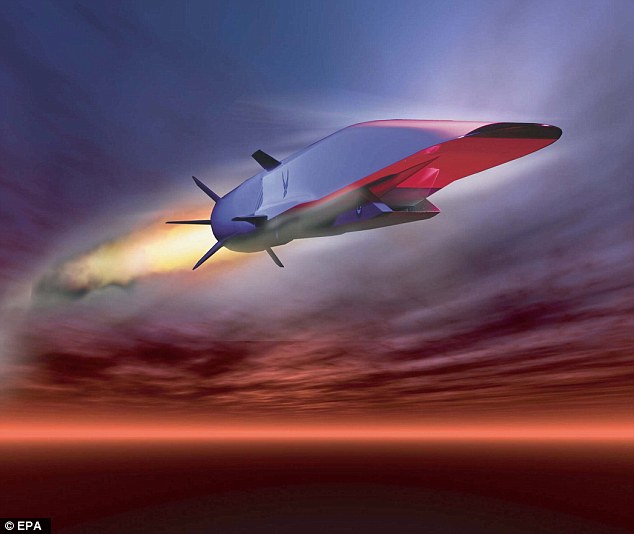Air Force bosses have revealed they hope to have a hypersonic plane capable of crossing countries in minutes by 2023.
Several tests of hypersonic projectiles have already been carried out.
Air Force Chief Scientist Mica Endsley told Military.com that the Air Force and DARPA, the Pentagon's research entity, plan to have a new and improved hypersonic air vehicle by 2023.
'X-51 was really a proof of concept test,' he said.
'It showed that you could get a scram jet engine, launch it off an aircraft and it could go hypersonic.
'It was able to go more than Mach 5 until it ran out of fuel.
'It was a very successful test of an airborne hypersonic weapons system.'
The new air vehicle could be used to transport sensors, equipment or weaponry in the future, depending upon how the technology develops.
Previously bosses had only said they hoped that missile systems would be available for testing in 2020.
'Our goal is to make sure the Air Force has the knowledge in 2020 or over the next five years to be able to make acquisition decisions using this technology,' Kenneth Davidson, manager of the hypersonic materials development at the Air Force Research Laboratory had told Military.com
Carrying a small, conventional warhead, a hypersonic weapon could be used as a stand-off missile, so the military could strike targets at a safe distance without putting pilots and aircraft at risk.
'You could then attack defensive targets, those heavily defended or the time-critical targets in a very timely manner -- if it's a moving target, before it can move,' Davidson said.
Experimental unmanned aircraft developed for the U.S. Air Force have already gone hypersonic during tests off the Southern California coast, flying at more than five times the speed of sound.
The Air Force said Friday the X-51A WaveRider flew for more than three minutes under power from its exotic scramjet engine and hit a speed of Mach 5.1 last year.
The test marked the fourth and final flight of an X-51A by the Air Force, which has spent $300 million studying scramjet technology that it hopes can be used to deliver strikes around the globe within minutes.
The Advanced Hypersonic Weapon is part of a program to create a missile that will destroy targets anywhere on Earth within hours - travelling at speeds in excess of 3,500 miles-an-hour or Mach 5.
It is being created alongside other demonstration projects being developed by DARPA, including the Hypersonic Air-breathing Weapon Concept and the Tactical Boost Glide, both of which have test flights scheduled for 2018 or 2019.
The same technology could also revolutionise air travel - although military bosses have their own goal.
'We are the Air Force. What do we want to do with this technology? We want to weaponize it,' Ryan Helbach, an official with the Air Force Research Laboratory, said last week during an exhibition at the Pentagon to showcase various military research projects.
'The follow-on program to this is the High Speed Strike Weapon effort. It's taking a lot of the lessons learned and the technology and moving to a weapons acquisition.'
The technology is also the subject of an arms race between the US, Russia and China.
'Certainly, the U.S. is not the only country involved in developing hypersonic weapons,'
Mica Endsley, the Air Force's chief scientist, said in a recent interview with Military.com
'They (China) are showing a lot of capability in this area. The advantage of hypersonics is not just that something goes very fast but that it can go great distances at those speeds.'
She added, 'For example, currently today to get from NY to LA is a five hour flight in a commercial aircraft. With a hypersonic weapon, you could do that same thing in about 30 minutes. You can go great distances at great speeds.'
The previous three flights ended in failure or didn't reach the intended speed.
Though the aircraft was designed to reach Mach 6, or six times the speed of sound, program officials were satisfied with its performance in the latest test.
'It was a full mission success,' program manager Charlie Brink of the Air Force Research Laboratory at Wright-Patterson Air Force Base said in a statement.
The sleek, missile-shaped WaveRider was released from a B-52 bomber 50,000 feet above the Pacific and was initially accelerated by a rocket before the scramjet kicked in.
It reached Mach 4.8 in less than half a minute powered by a solid rocket booster. After separating from the booster, the scramjet engine was ignited, accelerating the aircraft to Mach 5.1 at 60,000 feet.
The flight ended with a planned plunge into the ocean.
The WaveRider traveled more than 230 miles in six minutes, making it the longest hypersonic flight of its kind. Engineers gathered data before it splashed down.
Darryl Davis, president of Boeing Phantom Works, which built the WaveRider, called the test 'a historic achievement that has been years in the making.'
'This test proves the technology has matured to the point that it opens the door to practical applications,' Davis said in a statement.
While the Air Force did not have immediate plans for a successor to the X-51A, it said it will continue hypersonic flight research.
(Daily Mail)
www.ann.az
Follow us !











